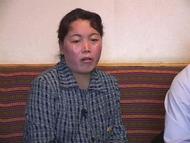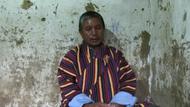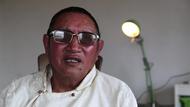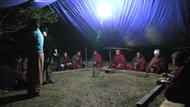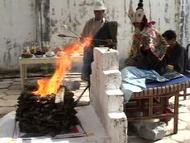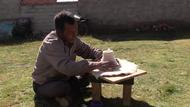Video Overview
Doctors in the Department of Liver Disorders discuss their work.
- ཨེམ་ཆི་ལགསད་ང་ཚོའི་མཆིན་ནད་ལྡེམ་བུ་དེའི་ནག་༼ནང་༽ལོགས་ལའང་དེ་འདུག་གཱ། ག་རེ་ཟེར་དགོས་རས། མཆིན་ནད་ལྡེམ་བུ་དེ་ལའང་སྣ་ཁ་མི་འདྲ་བ་ཆེ་བ་གཉིས་རེད།There are two different kinds of hepatitis B.
- ཨེམ་ཆི་ལགསགཅིག་ག་རེ་རས་ཟེར་ན་གདགས་དང་སྲིབ་ཟེ་གི་རེད་པཱ་ང་ཚོས་རེད་པཱ་ལགས་།They are called gDags and srib.
- ཨེམ་ཆི་ལགསག་རས་ཟེ་གི་འདུག་ན་་གདགས་ཀྱི་ངོས་ན་དབྱེ་བ་ཡིན་ན་གདགས་གསུམ་ཟེར་གྱི་འདུག་གཱ། དེའི་ནང་ནས་དབྱེ་བ་ཕྱེ་ཡས་འདུག་གཱThe so-called gDags can also be divided into three gDags, under which there are also some subcategories.
- ཨེམ་ཆི་ལགསདབྱེ་བ་ལྔ་ཡོག་རེད། ལྔའི་་ནང་ལོགས་ནས་ག་རེ་ཟེ་གི་འདུག་ན་དང་པོ། གསུམ་པ། ལྔ་པ་དེ་རྣམས་ཡིན་ན་དེའི་ག་རེ་ཟེ་གོ་རས་གདགས་ཀྱི་ཡིན་པ་ཡིན་ན་གདགས་ཆེན་ཟེ་གི་རེད་པཱ་གདགས་ཆེ་བ་ཟེ་གི་རེད་པཱ་།There are five subcategories of gDags, among which the first, third and fifth categories are called big gDags,
- ཨེམ་ཆི་ལགསཨ་ནི་དང་པོ་བྱས། ཨ་ནི་ །གཉིས་པ་བྱས། བཞི་པ་བྱས། དེ་འདྲའི་བཟོ་འདྲ་པའི་གདགས་ཡིན་པ་ཡིན་ན་གདགས་ཆུང་ཟེར་གྱི་འདུག་གཱ།while the first, second and fourth categories are called small gDags.
- ཨེམ་ཆི་ལགསདེ་འདྲའི་བཟོ་འདྲ་ཅིག་ཟེར་གྱི་རེད།It's something like that.
- ཨེམ་ཆི་ལགསའོ་དེ་འདྲས་ཀྱི་དེ་གཉིས་གཉིས་ཀྱི་ཐོག་ནས་སྨན་བཅོས་ཁག་གཉིས་ཀྱི་ཐོག་ནས་འདྲ་ཡི་མ་རེད་པཱ་སྨན་བཅོས་སྣ་ཁ་གཉིས་ཀྱི་ཐོག་ནས་བྱེད་ཀྱི་རེད་པཱ།In accordance with these two categories, the medical treatments are given in two different kinds.
- ཨེམ་ཆི་ལགསཡིན་ནའི་ག་རེ་རས་ཟེར་ན་ང་ཚོས་ཨ་ནི་ན་༼ཚ་༽་སྡུག་པ་འགོད་ནད་ཤུགས་ཆེ་བ་ཡོད་པ། འགོད་ནད་ཤུགས་ཆེ་བ་ཡོད་པ་དེ་འདྲའི་བཟོ་འདྲ་ལ།If [we found] serious diseases such as inflammations,
- ཨེམ་ཆི་ལགསགཅིག་ནས་ཐང་བསྟེར་ཡས། གཉིས་ནས་ག་རེ་རས་ཟེར་ན།syrup is given on one hand, on the other hand,
- ཨེམ་ཆི་ལགསང་ཚོས་ སྤྱིར་བཏང་ག་རེ་རས་ཟེར་ན་མཆིན་པར་སྲུང་སྐྱོབ་བྱེད་པ་དང་མཆིན་པའི་ཚ་བ་མཆིན་པའི་གཉེན་ཁ་བཅག་ཡས། མཆིན་པ་གསོ་ཡས་འོ་དེ་འདྲའི་ཆེད་དུ་ཡིན་ན་ང་ཚོས་ཟླ་བདུད་ཁ་ཚར་བཟོ་འདྲ་དེ་འདྲས་ཟླ་བདུད་ཡིན་ན་ཟླ་བདུད་རང་རེད།we give extra zla bdud in order to protect the liver, reduce the fever in liver and infection in liver. The zla bdud is zla bdud.
- ཨེམ་ཆི་ལགསཟླ་བདུད་དེའི་སྟེང་དུ་ང་ཚོས་ཁ་ཚར་རྒྱབ་དེ་འདྲས་བྱས་ཡོག་རེད།In addition to the [ordinary] zla bdud, extra [ingredients] are added.
- ཨེམ་ཆི་ལགསདེའི་སྟེང་དུ་གྷི་དགུ་ཁྱུང་ནག་བསྟེར་གྱི་ཡོག་རེད།Ghi dgu Khyung nag is given additionally.
- ཨེམ་ཆི་ལགསགྷི་དགུ་ཁྱུང་ནག་དེ་ལ་ཡང་ང་ཚོས་སྨན་གཅིག་ཁོ་ར་ཁོ་ར་ལོགས་སུ་ཕན་པའི་ཁ་ཚར་སྨན་དེ་འདྲས་རྒྱབ་ཡོག་རེད།We also have added some extra but helpful ingredients into the Ghi dgu Khyung nag.
- ཨེམ་ཆི་ལགསདགོང་དྲོ་དེ་ལ་སྤྱིར་བཏང་། གུར་མཆོག་བཟོ་འདྲ་དེ་འདྲ་དང་ཨུཏྤལ་ཉེར་ལྔ་སོགས་དེ་འདྲ་སྤྲད་ཀྱི་ཡོག་རེད།During the evenings, we give medicines such as Gur mchog and Au tpal Nyer nga.
- ཨེམ་ཆི་ལགསད་ཡིན་ནའི་གདགས་ཆུང་དེ་ལ་འགོད་ཡས་ཤུགས་ཆེན་པོ་མེད་པ་དང་གཉེན་ཁ་ཞེ་དྲག་མེད་དུས་་ན། ང་ཚོས་ཞོགས་པ་དྭངས་གཙོ་་འོ་དེ་དྲས་ཟོ་གྲབས་དེ་དྲས་བསྟེར་།If the small gDags is not infectious and has no inflammation, we give medicines such as Dwang gtso in the mornings.
- ཨེམ་ཆི་ལགསདགོང་དྲོ་དང་ཉིན་དགུང་ཨུཏྤལ་ཉེར་ལྔ། དགོང་དྲོ་མཚམས་མཚམས་གྷི་གུ་ཁ་ཚར་བསྟེར་དེ་འདྲ་བྱེད་ཀྱི་ཡོག་རེད།During the afternoons and evenings, Au tpel Nyer nga is generally given, but sometimes Ghi gu Kha tshar is given during the evenings.
- ཨེམ་ཆི་ལགསདེ་ཚོ་སྤྱིར་བཏང་མཆིན་ནད་ལྡེམ་གུར་ཆ་བཞག་ན་དེ་འདྲས་ཀྱི་སྨན་བཅོས་བྱེད་ཀྱི་ཡོག་རེད་པཱ།Such medical treatments are given to the hepatitis B patients.
- ཨེམ་ཆི་ལགསད་ག་རེ་རས་ཟེར་ན།Why do [we] do it like this?
- ཨེམ་ཆི་ལགསང་ཚོས་མཆིན་ནད་སྨུག་པོ་རྒྱས་པར་ཆ་བཞག་པ་ཡིན་ནའང་། མཆིན་ནད་སྨུག་པོ་རྒྱས་པ་མཐའ་མ་དང་ཐོག་མ་།For example, icterohepatitis can be divided into beginning and end [phases].
- ཨེམ་ཆི་ལགསམཐའ་མ་ཐོག་མ་རེད་པཱ་ཐོག་མར་ཆ་བཞག་པ་ཡིན་ན་མཆིན་ཁྲག་སྨུག་པོ་རྒྱས་པ་གཞི་ནས་ད་ཕོག་པ་།Among these two kinds of icterohepatitis, the [beginning] of the icterohepatitis is the start [of the icherohepatitis],
- ཨེམ་ཆི་ལགསསྣ་ཐོག་པ་ཙམ་གྱི་ཡང་བ་དེ་འདྲ་རེད་པཱ།so it is light.
- ཨེམ་ཆི་ལགསདེ་འདྲ་ཡིན་ནའང་དེ་འདྲའི་སྐབས་སུ་ང་ཚོས་ན་ཚ་ལྟ་བུ་ཡིན་ན་སྡུག་རུ་མི་འགྲོ་བ་དང་དེའི་ཆེད་དུ་ག་རེ་་བྱེད་ཀྱི་ཡོག་རས་ཟེར་ན།However, when [a patient is experiencing the beginning of the icterohepatitis], in order to control the sickness, what we do is that
- ཨེམ་ཆི་ལགསམཆིན་ཁྲག་སྨུག་པོ་རྒྱས་པ་ཁོ་རར་བསམ་བློ་བཏང་བྱས་སྨན་བཅོས་བྱ་ཐབས་ཀྱང་བོད་ཀྱི་གསོ་བ་རིག་པའི་ནང་སྨན་ཡོད་ན་མེད་ན་གྲང་སྦྱོར་རེད་པཱ།concerning the medical treatment for the icterohepatitis, we [give] Grang sbyor, which is the best medicine can be found in the Tibetan medicine [for treating icterohepatitis],
- ཨེམ་ཆི་ལགསགྲང་སྦྱོར་བསྟེར་ཡས་བཟོ་འདྲ་དེ་འདྲ་དངgive Grang sbyor,
- ཨེམ་ཆི་ལགསཟླ་བདུད་ཁ་ཚར་བསྟེར་ཡས་དེ་དྲས་།and extra zla bdud.
- ཨེམ་ཆི་ལགསལགས།Yes, please?
- གྷི་ཙནGhi tsan,
- ཨེམ་ཆི་ལགསགྷི་ཙན་བསྟེར་བ་སོགས་དེ་འདྲ་བྱེད་ཀྱིཡོག་རེད།Ghi tsan etc. are given.
- ཨེམ་ཆི་ལགསད་ཨ་ནི་ག་རེ་རས་ཟེར་ན་མཇུག་ཏུ་མཇུག་ཏུ་དེ་ལ་མཆིན་ཁྲག་སྨུག་པོ་རྒྱས་པ་མཐའ་མ་ལྟ་བུ་ཡིན་ན་སྐྲན་ལ་འགྱུར་བ་དེ་འདྲ་བྱེད་ཀྱི་ཡོག་རེད་པཱ།At the end of the icterohepatitis [development], when the icterohepatitis approaches the end, it becomes cancer.
- ཨེམ་ཆི་ལགསདེ་ཚོར་ཡང་གཙོ་བོ་གྲང་སྦྱོར་དང་།During this stage, mainly Grang sbyor
- ཨེམ་ཆི་ལགསཟླ་བདུད་ཁ་ཚར་སོགས་སྤྱིར་བཏང་བྱས་ན་སྨན་རྣམས་ཆ་བསྐྱེད་ཏེ་སྨན་ཤུགས་ཆེ་རུ་བཏང་བྱས་བསྟེར་གྱི་ཡོག་རེད།and extra zla bdud etc. are given. But the proportions [of these medicines] are increased.
- ཨེམ་ཆི་ལགསམཆིན་ཁྲག་སྨུག་པོ་རྒྱས་པ་དེ་ཚོའི་ཐོག་ནས་བྱས་པ་ཡིན་ན་ང་ཚོའི་བོད་ཀྱི་གསོ་བ་རིག་པའི་ཕན་འབྲས་ཧ་ཅང་མཐོ་པོ་རེད།Regarding the [medical treatment] for the icterohepatitis, our Tibetan medicines are really effective.
- ཨེམ་ཆི་ལགསསྤྱིར་བཏང་གིས་ང་ཚོས་མཆིན་ནད་ལྡེམ་བུར་ཆ་བཞག་པ་ཡིན་ན།Generally speaking, for example, the hepatitis B
- ཨེམ་ཆི་ལགསང་ཚོའི་བོད་ལུགས་གསོ་རིག་ལས་ན་བ་མ་ཚོར་བ་ལ་སོགས་ཡོང་གི་རེད་པཱ་མི་།may not be felt [by the patients] according to our Tibetan medicines.
- ཨེམ་ཆི་ལགསང་ཚོའི་ངོས་ནས་བཤད་ན་ནད་པ་མང་ཆེ་བ་སློབ་གྲྭར་འགྲོ་ལ་ཁད་དུ་དང་།The most cases [we found of hepatits B] are the people who are leaving for schools soon
- ཨེམ་ཆི་ལགསལས་ཁུངས་ཀྱིས་གཅིག་གྱུར་ཏུ་གཟུགས་གཞི་བརྟག་དཔྱད་བྱེད་པ་ལ་བརྟེན་ནས་གཞི་ནས་མཆིན་ནད་ལྡེམ་བུ་ཡོད་པར་ཧ་གོ་ནས་བྱས་།or because the institutions made a common health check for the staff, and some people found out that [they have hepatitis B].
- ཨེམ་ཆི་ལགསགཞི་ནས་སྨན་བཅོས་བྱེད་པར་སླེབས་མཁན་མང་པོ་འདུགAnd then they come for medical treatment. There are quite a lot of these kind of patients.
- ཨེམ་ཆི་ལགསཡང་ཁག་གཅིག་ག་རས་ཟེ་ནSome patients are that
- ཨེམ་ཆི་ལགས༼ན་ཚ་སྡུག་པོ་བྱས། སྐབས་འཕྲལ་མཆིན་ནད་ལྡེམ་བུ་ན་བྱས་༽ཚ་བ་བརྒྱབ་ཡག་དང་ཟས་ལ་དྭངས་ཁ་མེད་པ། གཟུགས་པོ་ལྗིད་པོ་བྱེད་པ་ལ་སོགས་ལ་བརྟེན་ནས་འཚོལ་བར་ཡོང་མཁན་ཡང་འདུགbecause they had serious sickness or had hepatitis which caused fever and anorexia, or felt they were physically heavy, they came for [medical treatment].
- ཨེམ་ཆི་ལགསམང་ཆེ་བ་ནི་གཟུགས་པོར་བརྟག་དཔྱད་བྱས་དེ་བྱེད་ཀྱི་ཡོད་རེད།However, most patients discovered [they had hepatitis through a health check].
- ཨེམ་ཆི་ལགསང་རང་ཚོའི་བོད་ལུགས་གསོ་རིག་ནང་མཆིན་ནད་ལྡེམ་བུ་ན་བ་མི་ཚོར་བ་ཞེས་བཤད་ཡོད་པ་རེད།In our Tibetan medicine, it is stated that [the patients do not feel any symptoms of] hepatitis [even if they have hepatitis].
- ཨེམ་ཆི་ལགསམཆིན་ནད་ལྡེམ་བུ་ན་བའི་སྐབས་ཚ་བ་རྒྱག་པ་དང་།When [a person] has hepatitis, [s/he] won't have a fever,
- ཨེམ་ཆི་ལགསགཉེན་ཁ་རྒྱས་པ་དང་མ་རྒྱས་པ་སྐྱུག་པ་སྐྱུགས་པ་དེ་འདྲ་བྱེད་ཡོད་པ་མ་རེད།inflammation, or vomit.
- ཨེམ་ཆི་ལགསཡིན་ནའང་གཟུགས་གཞི་བརྟག་དཔྱད་བྱེད་པའི་སྐབས་མཆིན་ནད་ལྡེམ་བུ་ཡོད་པ་ཧ་གོ་གི་ཡོད་པ་རེད།However, when the health condition is examined, one discovers that they have hepatitis.
- ཨེམ་ཆི་ལགསདེ་འདྲ་སོང་ཙང་མཆིན་ནད་ལྡེམ་བུ་ན་མཁན་ལ་ཤས་ནི་མཆིན་ནད་ལྡེམ་བུ་ན་མཁན་ལ་ཤས་ནི་མཆིན་ནད་ལྡེམ་བུ་ན་བའི་ཐོག་མའི་སྐབས་དཔེ་ཆ་བཞག་ན།Therefore, some of the hepatitis patients, when they are at the beginning stage, for example,
- ཨེམ་ཆི་ལགསགཟུགས་པོ་བདེ་པོ་མེད་པ་གཉིད་མ་ཁུག་པ་དེ་ནས་ག་རས་ཟེ་ན་༼གཟུགས་པོ༽ལྗིད་པོ་བྱེད་པ་སོགས་དེ་འདྲ་བྱེད་ཀྱི་ཡོད་པ་རེད།they don't feel comfortable physically, [they may have] insomnia, and [they feel that they are] physically heavy.
- ཨེམ་ཆི་ལགསནད་རྟགས་དེ་འདྲའི་རིགས་ལ་ང་ཚོའི་སྨན་ཁང་ནང་ནད་བསྡོད་སྨན་བཅོས་བྱས་པ་ཡིན་ན་In the cases of such symptoms, [if the patients] stay at our hospital and get medical treatment,
- ཨེམ་ཆི་ལགསཉིན་བདུན་ནང་ཚུན་ལ་ནད་རྟགས་ཡོངས་རྫོགས་ཞི་འགྲོ་གི་འདུགthe symptoms will disappear in seven days.
- ཨེམ་ཆི་ལགསཡིནའང་ན་ཚར་རྫས་འགྱུར་ཐོག་གི་བརྟག་དཔྱད་བྱེད་དུས་ན་ཚ་དེ་གBut while the sickness is examined by chemical diagnosis, the sickness
- ཨེམ་ཆི་ལགསལུས་ལ་ཞེན་བྱས་སྡོད་ཀྱི་ཡོད་སྟབས་དུས་ཡུན་རིང་པོའི་སྨན་བཅོས་བྱེད་དགོས་ཆགས་ཀྱི་ཡོད་པ་རེད།[is found] still in the body, which needs long-term medical treatments.
 Loading ...
Loading ... 





















































